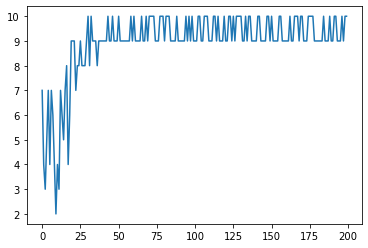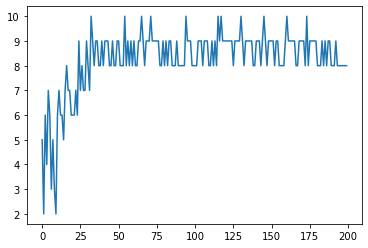One-Max Problem¶
One-Max is a simple problem often used to introduce the concept of genetic algorithms. The problem boils down to one question: what is the maximum sum of a bitstring (a string consisting of only 1s and 0s) of length N?
This tutorial will show how this problem can be solved in PyGlove’s way, with an option to use user-defined genome encoding.
(Disclaimer: PyGlove is designed to be used with problems with evaluation time greater than sub-second, since the onemax problem can be evaluated in nano/micro-seconds, you may find slowdown in PyGlove’s solution. Bear in mind that the overhead from PyGlove for each iteration is in sub-seconds)
!pip install pyglove
Solving One-Max with pg.oneof¶
First we show that the search space can be expressed with pg.oneof, a PyGlove’s built-in primitive for search space specification.
import pyglove as pg
import matplotlib.pyplot as plt
def one_max(search_space, search_algorithm, num_trials=200) -> None:
best_sequence, best_reward = None, None
history = []
for sequence, feedback in pg.sample(
search_space, search_algorithm,
num_examples=num_trials):
reward = sum(sequence)
if best_reward is None or best_reward < reward:
best_sequence, best_reward = sequence, reward
feedback(reward)
history.append(reward)
print(f'Best sequence: {list(best_sequence)} (sum={best_reward})')
plt.plot(list(range(num_trials)), history)
plt.show()
N = 10
search_space = pg.List([pg.oneof([0, 1])] * N)
search_algorithm = pg.evolution.regularized_evolution(
population_size=20, tournament_size=10)
one_max(search_space, search_algorithm)
Best sequence: [1, 1, 1, 1, 1, 1, 1, 1, 1, 1] (sum=10)

Solving the same problem with custom genome encoding¶
At times, users might want to encode the search space without using PyGlove’s built-in search primitives, when they have a more efficient genome representation, or to support new semantics of the search space (e.g. variable number of decision points). In such cases, PyGlove allows the user to define their own search primitives by extending pg.hyper.CustomHyper. The user needs to implement custom_decode method, which takes a pg.DNA with string value and returns its corresponding client object for evaluation. In this case, the client object is a list of binary integers.
The user needs to also implement a mutator for such custom-encoded DNA, and provides a DNA generator for generating the initial population. The custom mutator can be combined with PyGlove’s built-in evolution operations to create new algorithms.
import random
class BitString(pg.hyper.CustomHyper):
def custom_decode(self, dna: pg.DNA):
assert isinstance(dna.value, str)
bitstr = dna.value
return [int(x) for x in bitstr]
class MutateOneBit(pg.evolution.Mutator):
def mutate(self, dna: pg.DNA):
bitstr = dna.value
assert len(bitstr) > 0
index = random.randint(0, len(dna.value) - 1)
new_bitstr = (bitstr[:index]
+ ('0' if bitstr[index] == '1' else '1')
+ bitstr[index + 1:])
return pg.DNA(new_bitstr)
def init_population(population_size, n):
@pg.geno.dna_generator
def initializer(dna_spec):
for _ in range(population_size):
bits = [str(random.randint(0, 1)) for _ in range(n)]
yield pg.DNA(''.join(bits))
return initializer()
search_space = BitString()
search_algorithm = pg.evolution.Evolution(
(pg.evolution.selectors.Random(10)
>> pg.evolution.selectors.Top(1)
>> MutateOneBit()),
population_init=init_population(10, N),
population_update=pg.evolution.selectors.Last(20))
one_max(search_space, search_algorithm)
Best sequence: [1, 1, 1, 1, 1, 1, 1, 1, 1, 1] (sum=10)
